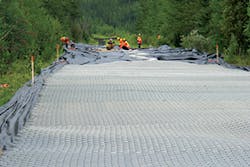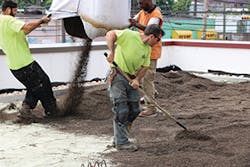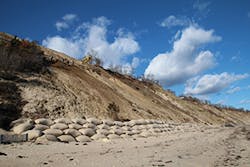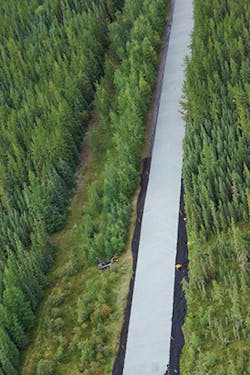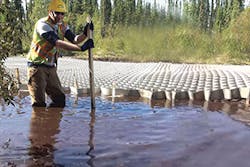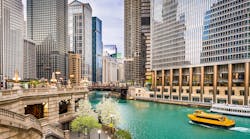Most people going about their day are not aware of the many uses of geosynthetic materials around them. Certainly back in the 1950s and ’60s, few people could envision how widespread these materials’ use would become, from the filter fabric protecting a storm drain to the underlayer of permeable pavers to a tubular structure helping to stabilize a shoreline.
Green Roofs Go to School
When Philadelphia-based Mastery Charter Schools had its Camden, NJ, school designed, school officials were adamant about two goals: they wanted a better learning environment for students and the newest technology for stormwater management. Jure Šumi, business development director of green solutions at Knauf Insulation, teamed up with architectural and design engineers in the Philadelphia area. Although the primary reason for the new school’s 3,000-square-foot green roof was stormwater control, Mastery Charter Schools understood that when students have a view of natural green landscapes from the classroom, they have healthier behavior patterns and their academic achievements are enhanced.
Adding the engineered growing medium to the green roof at Mastery Charter Schools
These children, and empowering them in the classroom, are the schools’ purpose. In Mastery’s Pennsylvania and New Jersey schools combined, 13,500 students are enrolled with 3,500 alumni to date. The goal is for each student to be prepared for post-secondary education—and to succeed there. “Think critically–act independently!” is the schools’ motto. Many of the students in Camden come from the lowest-performing schools in the state and from the areas with high rates of violent crime.
“Mastery Schools carries their message everywhere,” says Charles Chelotti of Engineering Design Studio. “In another building of theirs I was in, I noticed that in every single spot they have inspirational quotes, and the college banners are everywhere.”
Research from the Department of Landscape Architecture at the University of Illinois at Urbana-Champaign has demonstrated that when students have a view of green outside a classroom window, they perform better, as compared to students in a windowless room or with a window overlooking built-up space. In the test, 94 high school students with a green view outside a classroom increased their attention capacity by up to 13%. Additionally, students with green views demonstrated better physiological recovery from stress. Researchers speculated that when we stop focusing, our attention is involuntarily directed to other less stressful things. Because focusing on these things doesn’t require any effort on our part, it provides the brain time to rest and re-establish focus. The researchers hope that these findings will help designers, planners, and policy makers to identify school placements where there are trees and open space already, or where they can install features such as green roofs.
“Many large cities are highly impervious, built with asphalt, brick, steel, and concrete. Installing green roofs on rooftops helps bring nature back to the urban centers, restoring the natural hydrologic cycle—typically the job of traditional ground-level green space,” says Sasha Aguilera, design ambassador for Stormwater Capture Co. “In cities, vegetated roofs help capture rainfall onsite, many stories up and in some cases out of sight of the general public–doing the job of nature, retaining and detaining runoff.”
When Mastery Schools first approached Blackney Hayes Architects, school officials were interested in combining the latest in stormwater management with learning tools that teachers could incorporate with their curricula. Designers incorporated the StormCap pre-vegetated system from Stormwater Capture Co. on the roof. The system lies on top of Urbanscape’s needled mineral hydro blanket, which is manufactured by Knauf Insulation. The roof was just the start, however. Designers also incorporated 8,000 square feet of pervious surface in the 40,000-square-foot asphalt parking area. They also installed 5,000 square feet of grass pavers in the fire lanes.
These are all things Mastery Schools felt were important, notes Chelotti. “The sustainability of the site was important to them. The parking area will reduce runoff by 30 to 40%.”
This is especially important because the older area in which the school was built has a combined sewer system. During heavy rainfall events, says Chelotti, the system discharges directly into the historical Cooper River, which is home to the local crew teams. The Delaware River runs through Camden as well. “Anything that hits impervious surfaces will go straight into the rivers here.”
The school’s vegetated roof is visible from classrooms on two levels. “In the construction of this new facility, the green roof presented a very economical and environmentally friendly stormwater solution,” says Joseph Ferguson III, chief operating officer at Mastery Charter Schools. “It also provides an educational opportunity. Our teachers are excited and are looking forward to program the space in the future. We want students to be able to appreciate it. We want it to be part of the science program by explaining why we have it, how it works, and how it helps the environment.”
The vegetated roof has additional benefits for the building, such as cooling, reducing the heat island effect, and extending the lifespan of the roof system. Using the latest technology on climate data for the Philadelphia area, Šumi concluded that after green roof installation, there would be approximately 0.8 kilowatt hour per square foot less energy coming into the building in summer, and 0.3 kilowatt hour per square foot less energy loss occurring in the winter. Additionally, Mastery Schools committed to building a U-10 soccer field on one of the lots close to the school and is planning to use no artificial turf, says Chelotti.
“They literally redefined a neighborhood,” he adds. “And we’ll do whatever we can to help them incorporate the green roof into their class plans when they develop their curriculum. I can’t say enough about Mastery Schools.”
The green roof system used at the school maximizes stormwater retention while decreasing the amount of weight added. The hydro blanket acts as a water reservoir for stormwater management and to help support the pre-grown sedum mats. Once the live mats are delivered to a work site, it’s recommended they be installed within 24 hours. Ganter Contractors met this goal at the school and installed the 3,000-square-foot vegetated roof in less than a day.
“The amount of rainfall a vegetated system can capture depends on its components,” says Aguilera, who regularly consults with designers and engineers on vegetated roof performance. “New technological developments such as the needled mineral hydro blanket greatly enhance the stormwater performance of vegetated roofs while helping keep weight in check. Mastery’s Camden vegetated roof system is an example of a high-performing system retaining 2.6 inches of rainfall onsite.”
The StormCap system is a long-lasting, lightweight green roof that’s easily installed. Beginning with the root barrier and drainage mat, the nonwoven filter fabric is installed, preventing any particle erosion. Next, the blanket is put down for water retention, and the system is ready for a specially formulated growing medium and the live sedum blankets. When it’s saturated, the system will weigh only 28 pounds per square foot and measure approximately 5 inches thick.
As Chelotti concludes, “It may not seem like much to have that green roof, and the amount of pervious parking. But one starts, and then you get several together and it starts to make a difference. In all ways.”
White Cliffs Country Club
The White Cliffs Country Club has a long history of battling coastal erosion. The 130-acre gated community has private beaches that are situated between Sagamore and Scusset beaches to the south and Cedarville to the north along the Massachusetts coastline overlooking Cape Cod Bay. The 18-hole Gary Player Signature golf course offers a tram to the secluded beaches below. The development also features a restaurant, mineral pools, tennis courts,
and condominiums.
When the beach began eroding severely near the 18th hole, club officials knew it was time for some clear-cut intervention. The 18th hole sits atop a cliff that directly overlooks Cape Cod Bay and is considered one of the most scenic holes of the area.
Randy Parker, president of Land Management Systems Inc., explains that the bank vegetation ends north of the White Cliffs clubhouse, so the erosion had been “chewing down drift southerly. Long-term erosion rates in the White Cliffs area are around 1.7 feet per year. Bank erosion was threatening to collapse one of their golf greens.”
Parker, who is also a resident of nearby Plymouth, notes that the area is susceptible to shoreline destruction by nor’easter storms and Atlantic hurricanes. “[Hurricane] Jose pounded our beach with 30- to 50-mile-an-hour winds for four days,” he says. “Dropped the beach by five or six feet. High tide, in the nine-and-a-half-foot range, is on our stone revetment. We’ve never seen such a thing—no beach at high tide.”
A member of the Massachusetts Association of Land Surveyors and Engineers, Parker handled the permits for the White Cliffs project. “Only an Order of Condition from the Plymouth Conservation Commission was necessary. A simultaneous submission is made to Plymouth and DEP SERO [Department of Environmental Protection’s Southeast Regional Office]. The short answer is one permit, one jurisdiction, in this case.”
Some other coastal restoration projects along the same coast must undergo a lengthy permitting process. Ed Coletta, spokesman for the Massachusetts DEP, explains that it all ties into historical regulations that date back almost 40 years.
“The regulation went into effect in August 1978,” he notes. “So structures that were already there were grandfathered in. If a structure came after, they were no longer allowed to use hard structures like seawalls and bulkheads.” The idea behind the regulation, he says, is that it would encourage people not to build right up to the coastal edge. “They would maybe have to find a softer solution or move the building back.”
Joseph Little, managing director of Little Environments PLLC, provided construction oversight for what is called the “extended longevity coastal erosion management solution” at the country club. “Typical sandbags were not implemented on these projects. Composite geotextiles were used to improve the longevity of the fabric against the demising forces of sand abrasion and UV degradation over time,” he says.
Geosynthetic products including geocontainers and geotubes have been used in recent years for coast and shoreline protection and coastal restoration. Little also uses these geosynthetics for submerged environments and environments that become partially inundated by tides, waves, and storms.
He designed the system using geosynthetic ElcoRock containers. Long-established methods used in coastal restoration were dependent upon heavy machinery to move equipment to and from the site, along with moving sand, soil, concrete, and sometimes large boulders. Little’s method, however, minimizes the use of heavy machinery, therefore reducing the environmental impacts usually associated with these kinds of coastal restoration projects.
The shore protection system at White Cliffs Country Club
Enhanced filtration and their resistance to puncture, abrasion, and UV degradation make ElcoRock ideal for coastal projects like White Cliffs. They are becoming more accepted where “soft armor” is called for. Parker says the bags are made with polymeric fibers, with the inside of the containers being made of polyester and the outside made of polypropylene. Each unit is approximately 8 feet long, 5 feet wide, and 2 feet deep. When filled with 3 cubic yards of sand, each unit weighs about 5 tons. The individual units can be attached to each other and staked to form a shore protection system.
“The ability of the container to uniformly confine and cover the soil behind the containers is the key component of their longevity,” says Little.
Little avoided many of these problems using the ElcoRock containers, which are manufactured by an Australian geotextile manufacturer and are designed for coastal projects such as walls, groins, reef stabilization, and other flow-control structures. The containers are made from nonwoven, needle-punched staple fiber geotextile.
Once the containers are placed at their location for filling, water and sand are mixed into a slurry in a hopper and gravity-fed down a slurry line to the containers. Flow rate at the White Cliffs was 300 to 500 liters per minute through a 4-inch conveyance line. Once the slurry flows into the bags, water drains back out through the geotextile.
By filling with the gravity pull coming down the embankment, the geotextile is “pretensioned and filled to its fullest. This prevents the material from flapping in the wind and fabric shredding or tearing, common problems that cause bag failure,” he notes.
Because crews stockpiled sand adjacent to the hopper, they were able to fill containers without the need for a road being constructed on the beach. The use of a Bobcat expedited the process of pushing the sand into the hopper, which also eliminated the need for an excavator on the beach. Crews filled 120 geosynthetic containers over the course of 3 weeks. Little says they used approximately $200 to $300 of water from the local fire hydrant, but he adds, “at the end of the day, gravity is free.”
The Christina Lake project haul road
Floating Roads
Marc Breault, president and founder of Paradox Access Solutions, likes finding new and innovative solutions to infrastructure problems. Paradox is the distributor of Tough Cells (previously PRS-Neoweb) in North America. The cellular confinement system company, based in Alberta, services the pipeline, utility, municipal, general construction, and oil and gas industries.
When MEG Energy, a Canadian oil sands company, needed a 2-mile heavy-haul road constructed for its Christina Lake project during the summer months, it was a challenge to find contractors to build it. Typically, contractors build roads on the bog soil during winter months when the ground is frozen. As it warms up in the spring, everything melts and the materials settle in.
The Christina Lake project is located in the Southern Athabasca oil sands area, a little over 93 miles south of Fort McMurray in northeast Alberta. The problem was constructing the road within the right of way measuring a little less than 46 feet wide, and through the extremely poor soils and muskeg.
“I think the geocell business is a little futuristic,” says Breault. “The most common geosynthetics used are made of HDPE [high-density polyethylene], and they’re like the generics for the industry. But the problem is they have a creep factor.”
Breault sought out professionals to help develop a geocell made of NPA, novel polymeric alloy. “Dr. Sanat Pokharel developed the methodology,” he explains. NPA, also known as Neoloy, is composed of a thermoplastic engineering polymer and polyolefin. Where HDPE demonstrates low tensile strength and creep factor and responds to high temperatures, NPA provides stiffness and high tensile strength and performs better at high temperatures. All of this provides a longer lifespan for dynamic loading projects where strength and longevity are desired.
During road installation
When researchers evaluated the behavior of geocell-reinforced bases over stable and unstable subgrades, they found some advantages to NPA geocells including increased stiffness and load-bearing capacity, wider stress distribution, and reduced permanent deformation. These all contribute to prolonged roadway life for NPA geocells.
“We can design a road based on the life span the customer wants,” says Breault. “We can calculate the strength of the Tough Cells per square foot.”
On the Christina Lake project, the ground had a California bearing ratio (CBR) value of less than 1. The CBR is a penetration test developed by the California Department of Transportation before World War II to measure the load-bearing capacity of a soil base used for building roads. It compares the bearing capacity of the material to well-graded crushed stone, which has a CBR of 100%. The harder the surface, the higher the CBR. To put it in perspective, turf or moist clay has a CBR of around 4.75, moist sand around 10, and silt between 1 and 2.
Paradox built a floating road through the material, says Breault. “It was a huge challenge. If you watched the video, you saw guys in hip waders and even wetsuits.”
About 35,840 square meters (14 square miles) of the geocell material was delivered on pallets, ready to be rolled out and used on the road sections as they were ready. Construction began with an 800N nonwoven geotextile for separation. The crew in their hip waders literally pushed, stretched, and pulled the geotextile into place. “When you’re faced with three to six feet of water and vegetation, you use Mother Nature’s strength. That bog has a resistance.”
Breault explains that the first Tough Cell layer was needed to support construction equipment over very weak muskeg (peat) subgrade and to increase its bearing capacity. When the Tough Cells are infilled with sand, the cell-sand composite creates a “slab effect” that distributes loads from weaker areas to relatively stronger areas. This controls failure caused by strain softening of the weak subgrade and subsequently any possibility of progressive shear failure. Confinement of the cell strengthens the infill so that the material has a higher CBR.
“Once Tough Cells is laid down, the strength multiplies by a factor of 10,” says Breault. “So on a subgrade CBR far less than 1, now we’re at about 6 to 8 CBR, and after the second structural layer of Tough Cells, at the riding course, [we have] a CBR of greater than 60. Now all the stress is at the top of the road, and there’s very little vertical stress transitioning below—and that’s how you want it.”
As each layer was filled with sand, it was compacted with a 10-ton, 84-inch smooth drum roller. The access road required about 80,000 cubic yards of sand in total. But the sand was locally available and cheap, and as Breault notes, “It’s a road builder’s best friend because it compacts and consolidates so well.”
Finally, above the top layer of Tough Cells, the road was topped with 7 inches of gravel, totaling nearly 12,000 tons.
The road was designed for a 10-year life span. MEG Energy has been satisfied with how well it has performed during 5 years of heavy use. Because MEG Energy and the Christina Lake project were certified by the Wildlife Habitat Council, the company would ordinarily stockpile any sand, peat, or soil removed from a construction area and reuse it for reclamation when it is finished with a particular land lease. But the Tough Cells installation did not require excavation; the only materials to be removed will be the tons of sand and the geocell material, which Breault says will all be recycled.
